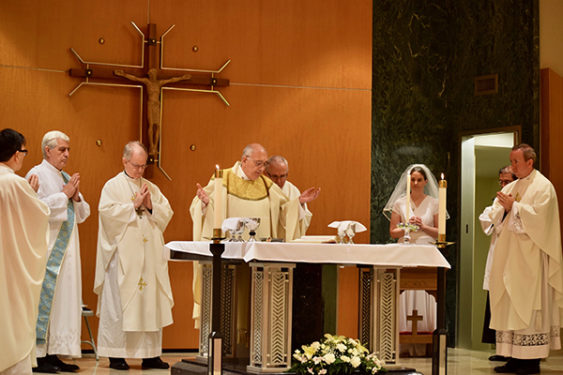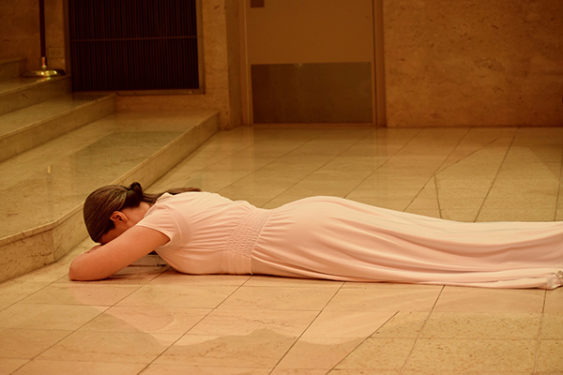
PARK SLOPE — Perfect weather was in place for Deborah Sucich’s nuptials on July 13 — moderate July heat with no clouds in sight.
Sucich works as a campus minister at St. Saviour H.S., Park Slope, just over a mile away from the diocesan chapel where her special occasion took place.
She was dressed in a long, simple, white dress. Her peppered gray hair was tied in a classic knot. Friends, clergy and family filled the Park Slope chapel aisles for the joyous moment.
Yet this wasn’t a typical wedding. Sucich was becoming a “consecrated virgin,” someone bethrothed to God.
Bishop Nicholas DiMarzio and auxiliary bishops from the Archdiocese of New York presided over the ceremony. The rite was one of the early church’s traditions of consecrated life — entry into the “Ordo virginum,” or Order of Virgins, where the community gathers for an Eucharistic celebration as the woman promises to remain a virgin for her whole life.
Sucich is now one of two consecrated virgins in the Diocese of Brooklyn.

“The day has been mystical,” Sucich said.
“Jesus and His Blessed Mother are truly present with us, and my hopes for the diocese and the future of the church is just an increase in abundant vocations and just that all people will realize the freedom that Christ is offering us in the Eucharist. I’m just so blessed that Brooklyn has welcomed me.”
It wasn’t until April 2018 that the Vatican released the document “Ecclesiae Sponsae Imago,” or the “Image of the Church as the Bride of Christ,” which explains the historical context, spiritual chrism, preparations, planning and faith formation of the vocation.
According to the document, some passages in the New Testament and in the writings of the first Christian centuries showed that this form of evangelical life appeared in spontaneous ways in different regions where church communities developed.
The rite of consecration that took place at the diocesan chapel follows the same solemn liturgical rite that has occurred since the fourth century: The community gathers for Mass, a diocesan bishop presides and pronounces the consecratory prayer, the woman expresses her holy resolution to remain a virgin for the love of Christ, and a nuptial symbolism takes place that involves putting the veil on the woman and giving her a ring — all as a public witness to the woman’s new consecrated vocation.
During Sucich’s discernment process, she received guidance from Sister Maryann Seton Lopiccolo, S.C., who works in the area of religious formation for the Diocese of Brooklyn.
Personal, Public Commitment
“It’s a personal commitment, but it’s a public commitment,” Sister Maryann said. “What she did was a public consecration in the Church. It’s an actual form of consecrated life like sisters, brothers and religious priests, consecrated virgins is another parallel to those commitments.
So today was ocially a public statement saying that I’m at the service of the church. To be lived about to the diocese where she was consecrated.” Jenna M. Cooper, a friend of Sucich’s who’s a judge and tribunal coordinator from the Diocese of Winona-Rochester, Minn., attended the rite in Brooklyn.
When Sucich was discerning, she was introduced to Cooper, who’s also a consecrated virgin.
“One really special thing about this is this is a vocation that’s only for women,” Cooper said.
“So just like priesthood is only for men, this is also one of the only vocations for women that’s really tied to a diocese and a local church … Consecrated virgins are the spiritual mothers of a diocese. You have that prayerful love and witness that supports the local church.”










































